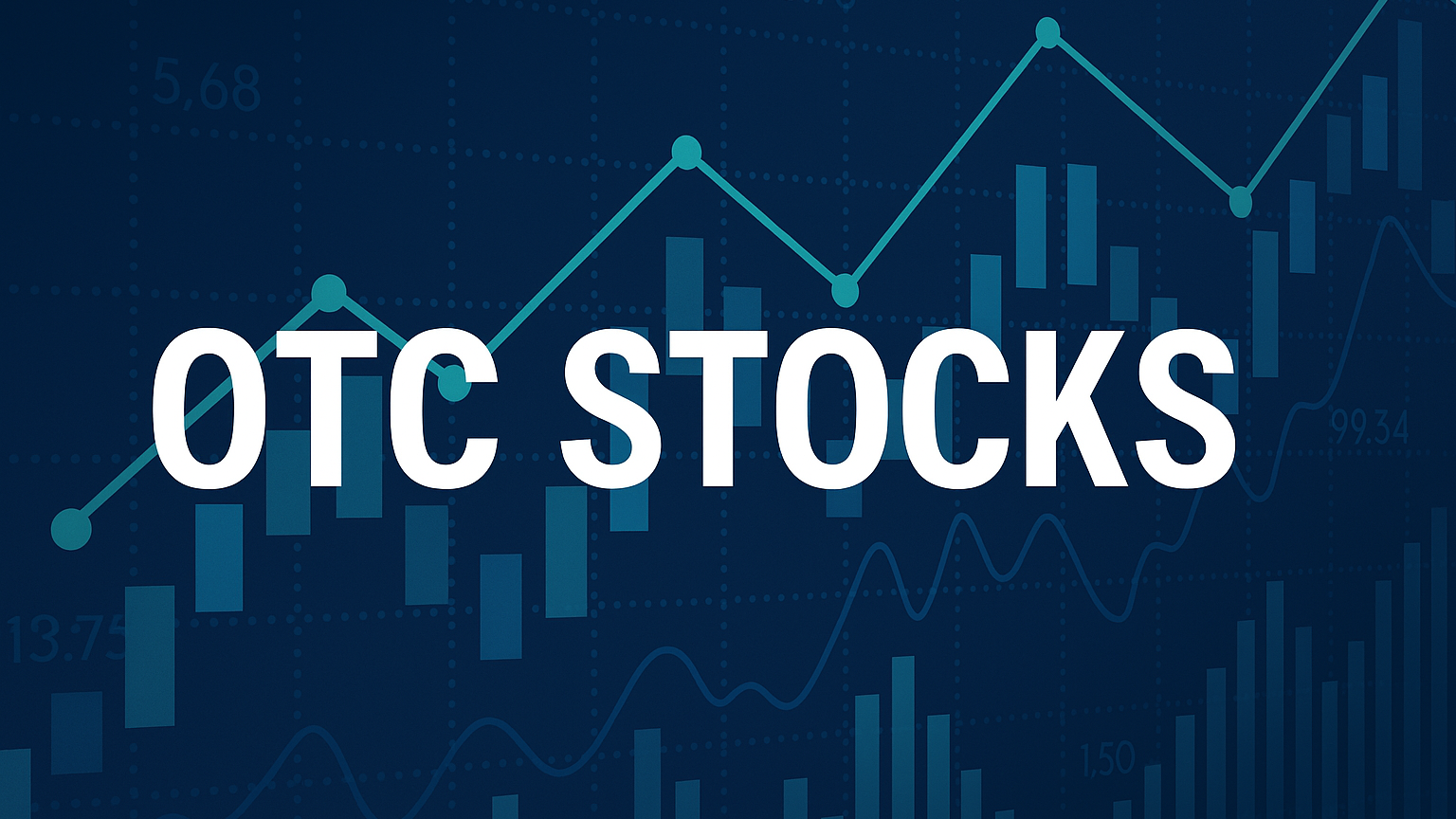Explore the complexities of OTC stocks, including their risks, rewards, and essential trading strategies for informed investing.
OTC (Over-the-Counter) stocks are securities traded outside major exchanges like NYSE or NASDAQ. Instead, they operate via decentralized dealer networks. These stocks often belong to smaller or international companies that don't meet exchange listing requirements.
Key Points:
- Market Tiers: OTCQX (most transparent), OTCQB (early-stage companies), Pink Sheets (highest risk).
- Risks: Low liquidity, price volatility, limited information, and higher fraud risk.
- Rewards: Access to small, emerging, or foreign companies and potential for high returns.
- Trading Features: Wider bid-ask spreads, higher transaction costs, and less regulation compared to exchange trading.
Quick Comparison of OTC vs. Exchange Trading
| Feature | Exchange Trading | OTC Trading |
|---|---|---|
| Platform | Centralized (NYSE) | Decentralized network |
| Transparency | High | Limited |
| Regulation | Strict SEC oversight | Less regulated |
| Costs | Lower | Often higher |
| Liquidity | High | Low |
OTC trading offers opportunities but comes with significant risks. Investors should approach with caution, conduct thorough research, and manage risks carefully.
Penny Stocks, Microcaps, and OTC Stocks Explained
How OTC Markets Work
OTC markets function differently from traditional exchanges. Instead of a centralized system, they rely on a network of broker-dealers who facilitate trades directly between buyers and sellers. This decentralized structure shapes how trades are executed and priced.
Trading Process
In OTC markets, trades happen through an electronic network where broker-dealers display bid and ask prices. This system helps with liquidity and price discovery. Platforms like Fidelity and Charles Schwab now allow retail investors access to these markets.
Here’s how the OTC trading process stands apart from exchange-based trading:
| Process Element | Description | Impact on Traders |
|---|---|---|
| Price Discovery | Prices are set by buyers and sellers | Bid-ask spreads are wider, making pricing less predictable |
| Trade Execution | Trades involve direct negotiations | Settlement takes longer, and transaction costs are higher |
| Market Making | Dealers hold inventories of securities | Liquidity improves, but price manipulation is a risk |
| Settlement | Settlements occur directly between parties | Counterparty risk is higher compared to exchanges |
"The OTC market is essentially just a lower-tier marketplace for smaller companies that trade less often, don't make as much, their prices are lower, [and] their volumes are typically lower." - Randy Frederick, Managing Director of Trading and Derivatives at Schwab Center for Financial Research
This structure brings unique challenges, especially with low trading volumes and liquidity.
Price and Volume Issues
OTC stocks often face low trading volumes, which can lead to price swings, liquidity problems, and strategy hurdles for investors.
Price Volatility: Even small trades can cause noticeable price changes. For instance, microcap stocks with market values between $50M and $300M are especially prone to sharp price shifts due to limited trading activity.
Liquidity Constraints: Selling large positions can be tough because there are fewer buyers. Market makers may lower prices, making it harder to sell, even if the stock appears profitable on paper.
Trading Strategy Considerations: To navigate these challenges, investors can:
- Use limit orders rather than market orders to control trade prices
- Break large trades into smaller, manageable blocks
- Check trading volumes before committing to a position
- Be ready to hold investments longer due to limited liquidity
These factors make OTC trading more complex and require careful planning for both entry and exit strategies. While retail investors participate actively, institutional players like hedge funds, asset managers, and pension funds also trade in this space, creating a diverse yet demanding environment.
OTC Trading Risks
This section outlines the risks involved in OTC trading, building on its operational differences.
Limited Company Information
One major challenge with OTC trading is the limited information available compared to stocks listed on major exchanges. Investors need to dig deeper by reviewing SEC filings, checking OTC Markets for tier classifications, reaching out to company management, and confirming state registration. For more details, see the OTC Market Types section, which explains the tiers and their disclosure requirements.
Price Swings and Manipulation
The low liquidity of OTC stocks often leads to price instability, making them vulnerable to manipulation. This can include sudden price spikes, inflated trading volumes, or coordinated schemes designed to influence stock prices.
"We encourage investors considering OTC stocks to generally approach them as speculative, high‑volatility investments that require careful research."
Fraud and Legal Risks
With less regulation, OTC markets are more exposed to fraudulent activity. According to the SEC, nearly half of all trading suspensions occur because companies fail to file required reports. Under the SEC's "Operation Shell Expel" initiative, launched in 2012, fewer than 1% of suspended stocks resume trading.
Common warning signs of fraud include:
- Frequent changes to the company name
- Unsolicited investment recommendations
- Unusual activity in previously dormant companies
- Frequent reverse stock splits
- Heavy promotion without clear business operations
To protect yourself, always verify a company's SEC filing status, review its operational history and management background, check for regulatory compliance, and be cautious of excessive promotional campaigns.
These risks underscore the importance of thorough research and why OTC stocks should typically make up only a small portion of a well-balanced portfolio.
OTC Trading Benefits
OTC trading comes with risks, but it also provides distinct opportunities for investors.
Small and Foreign Companies
OTC markets allow investments in smaller and international companies that aren't listed on major exchanges. With over 10,000 securities traded, these markets provide access to emerging and foreign businesses without the high costs of exchange listing fees.
One standout feature is the ability to trade foreign securities via American Depositary Receipts (ADRs). These trades occur during U.S. trading hours and use U.S. dollars, often resulting in lower commission costs compared to trading directly on foreign exchanges.
Growth Opportunities
For investors seeking growth, OTC markets can be an attractive option, especially in emerging industries and niche markets. While these investments come with higher risks, they also offer the chance for substantial returns. This makes them a potential avenue for spotting undervalued companies early.
"It may be easier to double your money faster, but that can also be a con because it would be easier to lose all your money faster as well."
Portfolio Addition Benefits
OTC stocks can also play a role in diversifying portfolios by providing access to emerging companies and unique sectors.
| Type | Benefit |
|---|---|
| Geographic Diversity | Access to international markets and emerging economies |
| Sector Exposure | Investment in niche industries not found on major exchanges |
| Market Cap Range | Opportunities in micro and small-cap growth stocks |
| Trading Flexibility | Direct negotiations with dealers |
"OTC markets are most suitable for investors who are comfortable with risk, and/or interested in diversifying their portfolios through access to foreign markets."
When trading OTC stocks, using limit orders is recommended due to lower liquidity and wider spreads.
Smart OTC Trading Steps
To make the most of OTC trading, following a well-thought-out approach is key.
Research Methods
Because OTC stocks often come with limited information and higher risk, doing your homework is a must. Start by reviewing SEC filings, like Form 10-K for annual reports and Form 10-Q for quarterly updates. Focus on these essential financial metrics:
| Financial Metric | What to Evaluate |
|---|---|
| Revenue Growth | Year-over-year trends and consistency |
| Net Income | Profitability and earnings stability |
| Return on Equity (ROE) | Efficiency in using shareholder funds |
| Return on Assets (ROA) | Efficiency in using assets |
| Price-Earnings Ratio | Valuation compared to industry peers |
"Buy into a company because you want to own it, not because you want the stock to go up." – Warren Buffett
Beyond numbers, take a closer look at the company’s business model, competitive strengths, and management quality. Compare these factors to industry averages to assess how the company stacks up.
Once you’ve done your research, focus on minimizing risks to protect your investments.
Risk Control
Managing risk effectively is just as important as making the right trades. Here’s how you can do it:
- Position Sizing: Avoid putting too much of your portfolio into a single OTC stock.
- Stop-Loss Orders: Set clear stop-loss levels to limit potential losses. Trailing stops can help lock in profits as prices move in your favor.
- Limit Orders: Use limit orders to control the price you pay or receive, and keep an eye on trading volumes to ensure smooth exits.
Analysis Tools
Today’s traders can leverage advanced tools to evaluate OTC stocks. Here are three popular platforms:
- StocksToTrade: Known for its robust scanning features and real-time data integration.
- TradingView: Offers real-time charts and advanced technical analysis tools, perfect for monitoring price movements and volume.
- TC2000: Lets you create highly specific filters using both technical and fundamental criteria.
These platforms help you stay on top of volume trends, price patterns, news updates, and fundamental data - all in real-time.
OTC Market Level Differences
OTC trading is divided into three levels, each with its own set of requirements. Understanding these differences is key to making informed investment decisions.
| Market Tier | Key Requirements | Financial Standards | Investor Protections |
|---|---|---|---|
| OTCQX | - Two independent directors - Audit committee - Annual shareholder meetings - Professional third-party sponsor |
- Audited financials by PCAOB firms - Financial reports released 15 days prior to meetings - Highest transparency standards |
- Strong corporate governance - Compliance with U.S. securities laws |
| OTCQB | - Annual verification - Management certification - $0.01 minimum bid price |
- Current financial reporting - PCAOB-audited statements - Regular disclosures |
- Monitoring for venture-stage companies - Basic investor protections |
| Pink Sheets | - Varies by category: • Current Information • Limited Information • No Information |
- Optional audited statements - Flexible disclosure rules - Minimal requirements |
- Limited oversight - Higher risk potential - Variable transparency |
This breakdown highlights the standards within each tier, helping investors weigh the risks and opportunities of OTC trading.
OTCQX is the highest tier, featuring established companies with strong financials. For example, Roche, a major pharmaceutical company, trades on this tier. Jason Paltrowitz, Executive Vice President of Corporate Services at OTC Markets Group, explains:
"You can look at a OTCQX company like Roche and see that it is a transparent, financially sound company. That profile may be very different for a security traded on the Pink market, where flags help investors easily identify potentially higher risk. We're focused on using data and disclosure to create a transparent, high-performing trading market where established companies can leverage a cost-effective, less burdensome alternative to a stock exchange listing."
OTCQB, positioned between OTCQX and Pink Sheets, focuses on early-stage and developing companies. Meanwhile, Pink Sheets include a wide variety of businesses, categorized by their level of disclosure. Companies failing to meet minimum standards risk being moved to the Expert Market.
"Financial transparency is a key factor in building trust with investors, and it varies significantly across the different tiers of the OTC market." - Dimov Audit
Each tier appeals to investors with different goals and risk tolerance. OTCQX attracts those looking for well-established companies with strong governance. OTCQB is better suited for those targeting early-stage growth opportunities. Pink Sheets, with their limited transparency, typically draw speculative investors comfortable with higher risks.
This tier analysis lays the groundwork for evaluating OTC stocks, complementing earlier discussions on market types and strategies.
OTC Trading Quick Guide
Here’s a streamlined overview of the key aspects of OTC trading, highlighting benefits and risks.
| Aspect | Benefits | Risks |
|---|---|---|
| Market Access | • Access to over 10,000 securities • Early-stage companies • Foreign stocks traded in USD |
• Limited transparency • Low liquidity • High price volatility |
| Cost & Flexibility | • Lower listing costs compared to exchanges • Flexible trading hours • Fewer regulatory requirements |
• Challenges when exiting positions |
| Investment Potential | • Exposure to emerging markets • Portfolio diversification opportunities • Access to niche sectors |
• Risk of fraudulent activity |
Key Success Factors
1. Market Selection
Choose your OTC market tier wisely. For instance, OTCQX offers the most oversight and transparency. (Refer to OTC Market Types for more details.)
2. Risk Management
Use strategies like stop-loss orders, portfolio diversification, and staying updated on market trends to manage risks effectively. Check the Risk Control section above for more tips.
3. Due Diligence
Thoroughly evaluate:
- A company’s financial health and operations
- The background and credibility of its management team
- How it stacks up against competitors in its industry
"OTC trading presents opportunities for stock investors targeting niche and emerging sectors." – The Edge Digest
Smart Trading Practices
- Work with reputable dealers
- Stay informed through market news and economic reports
- Verify the legitimacy of contracts before committing funds
- Treat OTC investments as speculative and conduct in-depth research
OTC stocks can add high-risk elements to your portfolio. The OTCQX tier offers a balance of opportunity and safeguards, but less regulated tiers demand extra vigilance. Use this guide alongside the detailed market tier breakdown for informed decision-making.
Summary
OTC trading offers both opportunities for growth and inherent risks. These markets can open doors to emerging companies and growth prospects but require thoughtful planning and careful evaluation. Here's a recap of the key points discussed earlier.
OTC markets often sacrifice transparency for accessibility. For example, the cannabis industry highlights this tradeoff, with U.S. cannabis sales expected to hit $71 billion by 2030. This illustrates the growth potential within OTC markets.
Experts suggest keeping OTC investments to just 5-10% of your overall portfolio.
| Aspect | Consideration | Action Step |
|---|---|---|
| Market Selection | OTCQX includes only 4% of traded stocks | Focus on top-tier OTC markets |
| Risk Management | Confirm regulatory compliance | Check SEC registration status |
| Due Diligence | Regular monitoring required | Utilize FINRA's BrokerCheck tool |
Before diving into OTC investments, it's essential to:
- Review company documents thoroughly.
- Confirm regulatory registration through SEC EDGAR and FINRA BrokerCheck.
- Seek advice from qualified financial professionals.
"For investors considering OTC securities, it is crucial to conduct thorough due diligence, understand the hazards involved, and decide on investments with an eye toward your investment goals and risk tolerance".
The OTC market offers a mix of promise and risk, requiring a well-informed and balanced strategy. While the chance for substantial returns exists, success depends on diligent research, proper portfolio allocation, and a clear understanding of your financial goals. Use these guidelines to ensure your OTC investments align with your overall strategy.







